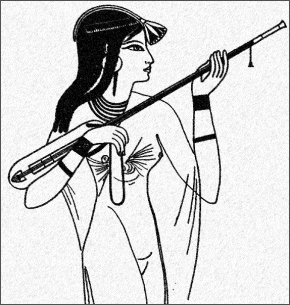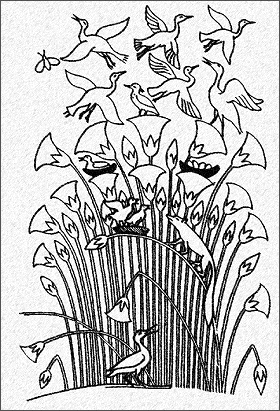

|
In order to interpret the historical period concerning 18 th dynasty last Pharaohs, it is necessary an exact organization of their familiar relations. In other words they must starting from the consideration that the Egyptian society was motherly hereditary; the inheritance, included the throne, was always put into mother line. A prince never could become Pharaoh being son of his father, but he had to be the husband of the daughter of the wife of the Pharaoh. In the royal harem, therefore, always a “great Queen” transmitted the royalty in virtue of the title of “main wife of the monarch”. We take in consideration the monarchs from 1414 to 1348 BC according to the chronology of C. Aldred: Tutmosi IV, Amenofi III, Amenofi IV/Akhenaton, Smenkh-ka-Re, Tut-ankh-Aton/Tut-ankh-Amun and Ay. At the end of 15 th century BC Pharaoh Tutmosi IV, the disinterring of the Sphinx, sealed an alliance pact with the Mitanni State (powerful Indo-European people of northern Syria), marrying the daughter of their King Artatama. In the Egyptian conception, this unprecedented event could mean that the Pharaoh had drawn outside his legal-religious origin (or a part of the origin) of the sovereignty. At the death of Tutmosi IV, its Amenofi son (born from the Queen Mut-em-wiya, identified with mitannic Artatama by many scholars), then seven-eight years aged, did not have any possibility to marry a sister, because they were not Tutmosi survivors daughters. Then a wedding was arranged with a little girl four years aged, Tiye, who not all the historians think of royal origin, a daughter of two spouses classify like “bourgeois”: Yuya and Tuyu. Yuya was in any case a much influential personage in the Egypt of the present age; he had a high military charge, the command of the war chariots cavalry, the most powerful army. His mummy, embalmed with one undoubtedly also for the ancient Egypt advanced technique, reveals European features: some passionate scholars of movie have not hesitated to compare him to the athletic figure of actor Charlston Heston. The aspect of Tuyu, on the contrary, was typically Egyptian.  Personally, we think that the choice on the small daughter of “Charlston Heston” cannot have been carried out that in order to newly cement the alliance with Mitanni. Yuya had therefore to belong to a group of Mitanni warriors, allocates in Egypt like “military councilmen”, perhaps quite like agents of the Asian people. Surely, until the attainment of the age of the reason by the young sovereign, he strongly represented the man of the empire. The same Tiye, as daughter of such a personage, did not have to be limited to play the role of a mere consort of the Pharaoh, but it seems that she has had a determining influence on the decisions of her husband. Amenofi III had at least three sons from his “main wife”: the eldest Sit-Amun, the designated heir Tutmosi that predated him, and his effective successor, Amenofi IV, who changed his name in Akhenaton. The scholars have founded that Amenofi IV did not marry his Sit-Amun sister but the mysterious Nefertiti, and do not know to explain the reason. Neither the familiar extraction of the new Queen is clear. P. Vandemberg identifies her with a certain Taduchipa, daughter of the mitannic King Tushratta, successor of Artatama, already secondary wife of the old Amenofi III, that it would be subsequently flown together to wedding with the new Pharaoh, assuming the name of Nefertiti. Such identification is not convincing, if is received the theory of Aldred; this one really thinks that both Amenofi’s (III and IV) has had approximately a decade of common regency. 28 th year of Amenofi III would correspond at the first year of the reign of his son. Indeed since Nefertiti married Amenofi IV/Akhenaton during the first year of reign, she cannot be identified with the Mitanni Taduchipa, that married old Amenofi III during 36 th year of reign of this last one; this year in fact corresponds at least to 9 th year of Akhenaton, who in that moment was already married with Nefertiti. Aldred assumes instead that Nefertiti was the daughter of the civil high employee Ay, and thinks that this one be a smaller brother of Queen Tiye. The Egyptologist has based his theory on a single indication: the circumstance that in some cases Ay is remembered like “Father of the God”, name that could mean “the father-in-law of the Pharaoh”; being Akhenaton the Pharaoh at that age, according to Aldred it would achieve that his wife (Nefertiti) was the daughter of the foretold Ay. To our opinion, the hypothesis is decidedly failing: it cannot be excluded, in fact, that Ay might have been the father of one secondary wife of Akhenaton. In other words, the name of one of they, Kya, would be come to a phonetically agreement with the name of the others descendants of “military councilman” Yuya (Yuya, Tiye, Ay, Kya).  We think, however, absolutely rejecting whichever supposition that replaces in argument the hereditary norm of the mother line. Contrarily at what it had happened for the rise to the throne of his father, Amenofi IV could not get the throne without marrying his sister Sit-Amun. It achieves that his sister Sit-Amun and his “main wife” Nefertiti were the same person, who changed name at the wedding with the heir of the throne. It is not hypothetical, in fact, that Queen Tiye has allowed the acquisition of the throne by anyone, without holding account of the rights and the prerogatives of her eldest daughter. The hypothesis of the writer, at last, is sealed from the title of “main wife of the monarch” often attributed to Sit-Amun, until 37 th year of her father. Since in ancient Egypt the incestuous relationships between father and daughter were publicly announced, it achieve that the monarch of which Sit-Amun was the main wife, could not be Amenofi III (whose “main wife” Tiye was still living), but the co-regent Amenofi IV/Akhenaton. Also Nefertiti’s standing, during the reign of Akhenaton, did not have to be merely representative, but, on the contrary, her political role wide was recognized as from the contemporaries, than from the historians of the antiquity. In the surveys of the Aton Temple in Karnak, the cartouche with the name of Nefertiti appears 564 times, versus only 320 of Pharaoh Akhenaton. The four more important historiographers of the period, Manetone, Flavio Giuseppe, Sesto Giulio Africano and Eusebio, agree themselves in thinking succeeded to Pharaoh Amenofi III “his daughter Achencheres (or Achencherserses)”, who reigned for a period of twelve years. It would seem nearly, by any considerations, than the Queen covered the political role of the age, while Akhenaton was exclusively training “Pontifex maximus” functions. Engaged in carrying ahead his “religious revolution”, finalized to the substitution of the ancient one with the cult of Aton, Akhenaton before would have left the Queen the real regency (1377-67), and then all the fates of State (1367-65). It’s to notice that the dates in issue confirm the twelve year reign attributed from the four cited historians to the mysterious Achencheres. Recent studies confirm too, for those years, the all effects attribution of the title of Pharaoh to a certain Neferneferuaton, longer version of Nefertiti name. Being still alive the enigmatic Akhenaton, it seems that, already at the death of Amenofi III (11 th year of co-regency of Akhenaton) Nefertiti has been associated to the throne of her husband/brother. Between 13 th and 14 th year of the reign of Akhenaton, however, at the same time of the death of Queen-mother Tiye, Queen Nefertiti disappears from every official raffiguration, so to be given for died from some important modern scholars (C. Aldred). It’s the probable interpretation of the happened facts. So a young prince (probably a stepbrother of the Pharaoh), a certain Smenkh-ka-Re, married the eldest daughter of Nefertiti, Merit-Aton, and, finding on such straight wedding, he was associated to the throne with Akhenaton himself. However, a passing her, the charisma of the Queen was so strongly that, as the new coregent turned out from a registration, he added himself the Neferneferuaton name too. The misfortunes, for the members of 18 th dynasty, at this age endured acceleration. Young Smenkh-ka-Re, in fact, died twenty years old, towards 17 th year of the reign of Akhenaton. A few months after, the death would have hit also this last one. We are not in a position knowing neither the causes of Smenkh-ka-Re death (being particularly ruined its mummy), neither those ones of Akhenaton and Nefertiti, not being still recovered their corpses. Therefore, we cannot really check if the passing of these monarchs was due to a true misfortune or to a power struggle without exclusion of blows between rival factions. Little Tut-ankh-Aton therefore occupied the throne for only nine years. The new Pharaoh, surely son of the deceased Tiye, and, a lot probably also of Amenofi III, had acquired the succession rights, marrying princess Anches-en-pa-Aton, second born daughter of Nefertiti. Logic makes us to deduce that the under-age Pharaoh was neither a submissive instrument in the hands of any unknown power. Towards the 4 th year of his reign, in fact, a new revolution happened. The Pharaoh and the Queen changed their own respective names in Tut-ankh-Amun and Anches-en-Amun and both left the Capital City of Akhenaton in order to move themselves to Thebes; the cult of Aton was abandoned and the ancient gods were restored. The powerful clergy of God Amun seems to have taken the power. But after nine years of reign Tut-ankh-Amun died only eighteen years old, and without living heirs. His passing was not due to natural causes. An observable contusion on the skull of his mummy makes thinking that he was been killed with a mace blow. Feeling herself in danger, Queen Anches-en-Amun asked aid quite to the people of Hittiti, offering herself to marry their real prince and conferring him therefore the throne of the Pharaohs. But the designated prince was killed too, in an ambush. Who was the author of this new military coup? Nearly sure Ay, the “Father of the God” of the times of Akhenaton, which forced to wedding the Queen, so succeeding to the young Pharaoh, prematurely assassinated. It would seem a return to the cult of Aton, but there are not any sure elements to support. The reign of Ay lasted, however only four years; at his death general Har-em-hab, completely connected to the God Amun Thaeban clergy, got on the throne. About Queen Anches-en-Amun more news is not had, neither turns out that she has had any heir. Neither the causes of Ay passing are known, not being be recovered his mummy. Har-em-hab acquired the sceptre through the marriage with princess Mut-nodjme, generally considered stepsister of Nefertiti. That is would confirm the hypothesis of the royalty of the blood of the consort of Akhenaton. Like Nefertiti, in fact, Mut-nodjme too could have acquired the royal title only being daughter of the ancient Queen Tiye, coulding have neither supposable noble birth. |

